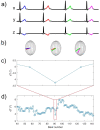ECG Ventricular Repolarization Dynamics during Exercise: Temporal Profile, Relation to Heart Rate Variability and Effects of Age and Physical Health
- PMID: 34574421
- PMCID: PMC8469015
- DOI: 10.3390/ijerph18189497
ECG Ventricular Repolarization Dynamics during Exercise: Temporal Profile, Relation to Heart Rate Variability and Effects of Age and Physical Health
Abstract
Periodic repolarization dynamics (PRD) is a novel electrocardiographic marker of cardiac repolarization instability with powerful risk stratification capacity for total mortality and sudden cardiac death. Here, we use a time-frequency analysis approach to continuously quantify PRD at rest and during exercise, assess its dependence on heart rate variability (HRV) and characterize the effects of age (young adults/middle-aged adults/older adults), body mass index (non-overweight/overweight) and cardiorespiratory fitness level (fit/unfit). Sixty-six male volunteers performed an exercise test. RR and dT variabilities (RRV, dTV), as well as the fraction of dT variability unrelated to RR variability, were computed based on time-frequency representations. The instantaneous LF power of dT (PdTV), representing the same concept as PRD, and of its RRV-unrelated component (PdTVuRRV) were quantified. dT angle was found to mostly oscillate in the LF band. Overall, 50-70% of PdTV was linearly unrelated to RRV. The onset of exercise caused a sudden increase in PdTV and PdTVuRRV, which returned to pre-exercise levels during recovery. Clustering analysis identified a group of overweight and unfit individuals with significantly higher PdTV and PdTVuRRV values at rest than the rest of the population. Our findings shed new light on the temporal profile of PRD during exercise, its relationship to HRV and the differences in PRD between subjects according to phenotypic characteristics.
Keywords: cluster analysis; electrocardiography; exercise test; heart rate variability; periodic repolarization dynamics; sympathetic nervous system; time-frequency analysis; ventricular repolarization.
Conflict of interest statement
The authors declare no conflict of interest. The funders had no role in the design of the study; in the collection, analyses, or interpretation of data; in the writing of the manuscript, or in the decision to publish the results.
Figures






References
-
- Pueyo E., Smetana P., Caminal P., De Luna A.B., Malik M., Laguna P. Characterization of QT interval adaptation to RR interval changes and its use as a a risk-stratifier of arrhythmic mortality in amiodarone-treated survivors of acute myocardial infarction. IEEE Trans. Biomed. Eng. 2004;51:1511–1520. doi: 10.1109/TBME.2004.828050. - DOI - PubMed
Publication types
MeSH terms
LinkOut - more resources
Full Text Sources
Medical
Miscellaneous

